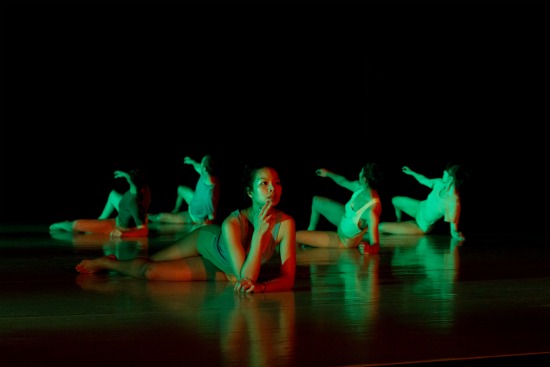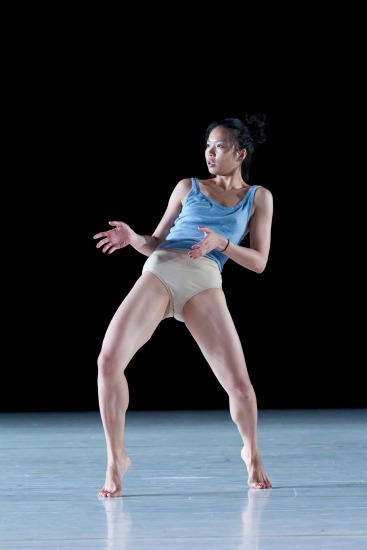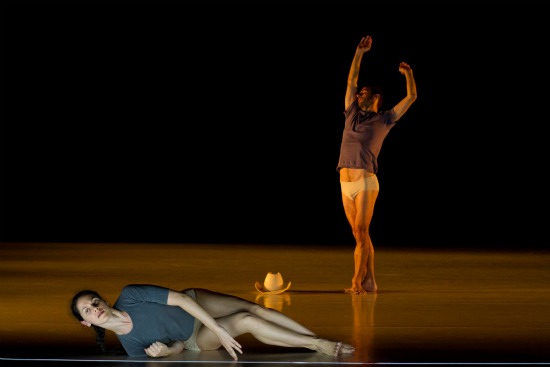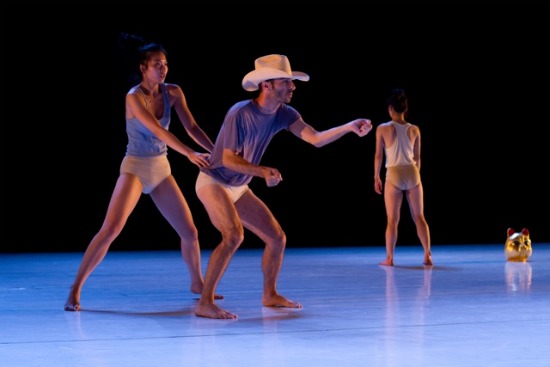You wouldn’t expect LeeSaar The Company’s new piece, Fame, to re-create the eyes-on-stardom world of the two movies and the television show that bear that name. Teenagers in New York’s High School of Performing Arts striving, bitching, and shining their way to success and successful hookups? No. The fascinating Fame choreographed by Lee Scher and Saar Harari—and premiered by Peak Performances at Montclair State University, March 28 through 31— deals with its subject obliquely, through the dramas of the body, rather than dramatic narrative.
Scher, an actress and playwright as well as a dancer and choreographer, and Harari, a choreographer and dancer, teamed up in 2000 and moved here from their native Israel in 2004. Fame, created in collaboration with their exceptional group of performers, unfolds as a collage of images that layer ambition, embarrassment, fear of failure, pain, desire to please, need for love, and more.
These emotions, of course, link LeeSaar’s Fame with its predecessors, but the ways in which the feelings are presented extend them beyond the notion of celebrity, and Harari and Scher want you to understand that. Their movement style has its roots in their study of Ohad Naharin’s Gaga technique, which means that no overt “ta-da!” presentations simplify the complexity of human movement. The bodies of the seven performers rarely make single statements. They could probably illustrate contemporary theories of multiple intelligences on the cellular level. It’s as if these gifted people are attempting to guide a liquid through channels inside their bodies and keep it moving. Whether seeking or evading an erect stance, they appear simultaneously strong and unstable, able to undulate one part and wrench another at the same time.
The seven performers come and go—sometimes walking onto the stage of the Alexander Kasser Theater matter-of-factly and sauntering away—sometimes slipping unobtrusively into view from behind three black panels at the rear of the stage that are almost invisible against the black curtain. Only occasionally do they dance in unison. In the silent beginning—atmospherically lit by Avi Yona Bueno (Bambi), who also did the stage design—five women introduce you to an important aspect of the style.
They’re not aiming for conventional beauty or poses that rest your eyes. They spread their feet apart and drop into a squat; they roll their torsos around and stick their butts out; they crane their necks like pecking chickens; they swing their knees to one side; their fingers tickle and grasp invisible substances around them. Unfortunately, the sentence I’ve just written divides and stops these moves. So imagine that all of them are happening at once, or, at least, in a continuous flow. These people are powerful and delicate, grotesque and gorgeous, and you can’t take your eyes off them. Nor are these movements happening to them without their permission; the performers seem to be choosing a pathway and monitoring whatever unexpected happens along the way.
I read that the creative process for Fame began with a solo for each dancer, and that is one of the piece’s connections with auditions or “acts.” Another is the music: fifteen cuts, beginning with “The Approaching Ice” from Patrick Hearn’s Glaciation and ending with “Neckbrace” from Ratatat’s LP4. Amy Dressendorfer is the first performer left alone on stage, but she’s quickly succeeded by Hsin-Yi Hsiang, and then by Harari. The only male in the group, Harari opts for the cowboy image, although he’s not dressed for the range. Tall, lean, and flexible, he, like the women, wears only off-white briefs and a tee-shirt. But he has a Stetson, and, occasionally, a hint of a bowlegged stance.
The solos get longer, and we become aware that the performers are often hyper-aware of us—casting looks our way to see what we think, or coming right down to the front of the stage and eyeing us. Are we potential producers, or are they casing us for a potential date? Hyerin Lee tries hard to engage us. Close to the front of the stage, she pulls from somewhere at the back of her dark red top, pairs of chopsticks to match. She seems uncertain what’s best to do with them. Never stopping her fluid motions, she stabs two sticks through her upswept hair, takes them out and attempts castanets, then figures they could be weapons. Hsiang has different needs; she becomes almost simian in one solo—waddling in a crouch, smacking her lips, and making low intermittent humming noises.
Candice Schnurr takes off her shirt and pants as she enters and drops them on the floor. Clad in a black bra and underpants, she embarks on some astonishing dancing, first touching her body, as if to assess its readiness for what she’s going to ask it to do. Staying in one spot for a while, she unfurls her long, slim arms and legs, stretching them out like taffy and spooling them in, while her body and head explore their own circuitous paths. Can someone undulate and jerk at the same time? These dancers can. Toward the end of Schnurr’s solo, the illumination dwindles down to only white footlights. It’s then that she comes closer to the audience and pointedly, but without expression, offers her spraddling legs, her high kicks, her grinds to us.
Scher’s first solo couldn’t be more of a contrast. She reclines on her side, propped up on an elbow, and sings a song in Hebrew very quietly and unpretentiously. This is also a contrast to her own later performance, when she grabs a mic from a stand and extravagantly lip-synchs a song. It is she who, toward the end of the dance, presents the need for approval most baldly. Sitting near the front of the stage, she asks the darkness in front of her, “So do you think I’m going to get the part?” Her voice is soft, innocent; all the while, she has lifted her hips slightly off the floor and is swinging them back and forth, seemingly unaware of what she’s doing.
I don’t want to give the impression that Fame is a string of solos. These overlap or emerge from group moments, one of which might even be termed a “routine.” Certain moves become motifs. Scher’s bathing-beauty pose reappears at other times in Fame— once assumed by three women at the same time. Another repeated pose is introduced, as I remember, by Jye-Hwei Lin: a woman walks onstage, sits facing the audience, spreads her legs, and stares at us.
Like Hsiang, Lin has been working with LeeSaar since 2007. The two of them bring a range of nuances to everything they do. Lin becomes the frontier woman to Harari’s cowboy persona. He enters riding, whipping on a mount who’s covering very little territory. He and Lin have a bit with an imaginary cigarette. Everyone else onstage freezes while she climbs on behind him for an increasingly bumpy gallop. He ditches her though, and urges his horse offstage, while, in silence and dimming light (cut to the closeup), Lin stares at us. Or at something farther away. A large, gold head, like that of a Chinese lucky cat has been placed on the floor. It’s staring too.
With the exception of Scher in her go-for-broke karaoke—the performers remain natural, however overt their actions. An intriguing disconnect exists between what they feel and what they do. There’s nothing oblique about the women presenting their crotches to the spectators, but how that action is arrived at or abandoned stirs up complicated thoughts that may slink or jolt through their bodies. And, actually, Scher’s “big” song doesn’t seek to charm us; she rages dutifully along with the recorded voice and disregards the taped applause when she’s done.
These performers get through to you as individuals—in part because they’re so uncannily skilled, but also because of the way they own the movement. As co-creators, they literally do own it, but that’s not the only reason they inhabit it so fully. Fame is like a quilt; there’s no building to a climax or coming up with a revelation to bind everything together. On opening night, the piece came to a sudden end. The lights went out, came on again, the dancers bowed, we applauded and cheered. The house lights were turned up; we struggled into our coats. Suddenly Dressendorfer, Hsiang, Lin, and Schnurr burst back onstage dancing gleefully. For about 20 seconds. I went up the aisle missing them already.




